Progress in the Knowledge, Application and Influence of Extremely Low Frequency Signals
Abstract
:Featured Application
Abstract
1. Introduction
2. Materials and Methods
- (1)
- Obtaining information about documents that contain the established keywords initially contained in the summary, title, or keywords fields of the document.
- (2)
- Extracting the information of the authors of the works mentioned in step (1), including for each author the Scopus identification number of the author, affiliations, publications, dates, number of citations, and H-index.
- (3)
- Processing to obtain the collaborative network of authors who have published articles that contain the search keywords.
3. Results and Discussion
3.1. Community Analysis
- “Environmental Health Criteria 238: Extremely Low Frequency Fields” with a total of 15 references [56].
- “Interaction of Static and Extremely Low Frequency Electric and Magnetic Fields With Living Systems: Health Effects And Research Needs” with 294 references [57].
- “Biological Responses to Electromagnetic Fields” with 307 references [58].
- “Schumann Resonance for Tyros: Essentials Of Global Electromagnetic Resonance In The Earth-Ionosphere Cavity” with 41 references [64].
- “Sprites, ELF Transients, And Positive Ground Strokes” with 286 references [65].
- “Criteria for Sprites and Elves Based on Schumann Resonance Observations” with 182 references [16].
- “Human Electrophysiological and Cognitive Effects of Exposure to ELF Magnetic And ELF Modulated RF And Microwave Fields: A Review Of Recent Studies” with 108 references [75].
- “A Replication Study of Human Exposure To 60 Hz Fields: Effects on Neurobehavioral Measures” with 109 references [76].
- “A Consensus Panel Review of Central Nervous System Effects of The Exposure to Low-Intensity Extremely Low-Frequency Magnetic Fields” with a total of 59 references [33].
- “Sensitive Broadband ELF/VLF Radio Reception with The AWESOME Instrument” with 126 references [88], (VLF: very low frequency, AWESOME: atmospheric weather electromagnetic system for observation, modeling, and education).
- “ELF and VLF Wave Generation by Modulated HF Heating Of The Current-Carrying Lower Ionosphere” with 95 references [4].
- “ELF and VLF Radiation From The Polar Electrojet Antenna” with 67 references [1].
- “Broadband ELF Plasma Emission During Auroral Energization 1. Slow Ion Acoustic Waves” with 97 references [96].
- “Propagation of Whistler Mode Chorus To Low Altitudes: Spacecraft Observations of Structured ELF Hiss” with 71 references [97].
- “Interferometric Determination of Broadband ELF Wave Phase Velocity Within A Region of Transverse Auroral Ion Acceleration” with 84 references [98].
3.2. Author Analysis, Afiliations, and Countries of Investigation in ELF
3.3. Analysis by Documents That Investigate in ELF
4. Conclusions
Author Contributions
Funding
Acknowledgments
Conflicts of Interest
References
- Barr, R.; Stubbe, P. ELF and VLF radiation from the “polar electrojet antenna”. Radio Sci. 1984, 19, 1111–1122. [Google Scholar] [CrossRef]
- Papadopoulos, K.; Chang, C.L.; Vitello, P.; Drobot, A. On the efficiency of ionospheric ELF generation. Radio Sci. 1990, 25, 1311–1320. [Google Scholar] [CrossRef]
- Cohen, M.B.; Moore, R.C.; Golkowski, M.; Lehtinen, N.G. ELF/VLF wave generation from the beating of two HF ionospheric heating sources. J. Geophys. Res. Space Phys. 2012, 117, 1–8. [Google Scholar] [CrossRef]
- Stubbe, P.; Kopka, H.; Rietveld, M.T.; Dowden, R.L. ELF and VLF wave generation by modulated HF heating of the current carrying lower ionosphere. J. Atmos. Terr. Phys. 1982, 44, 1123–1135. [Google Scholar] [CrossRef]
- Simões, F.; Pfaff, R.; Berthelier, J.J.; Klenzing, J. A review of low frequency electromagnetic wave phenomena related to tropospheric-ionospheric coupling mechanisms. Space Sci. Rev. 2012, 168, 551–593. [Google Scholar] [CrossRef] [Green Version]
- Schumann, W.O. Über die strahlungslosen Eigenschwingungen einer leitenden Kugel, die von einer Luftschicht und einer Ionosphärenhülle umgeben ist. Zeitschrift für Naturforschung A J. Phys. Sci. 1952, 7, 149–154. [Google Scholar] [CrossRef]
- Balser, M.; Wagner, C.A. On Frequency Variations of the Earth-Ionosphere Cavity Modes. J. Geophys. Res. 1962, 67, 4081–4083. [Google Scholar] [CrossRef]
- Lai, H. Exposure to Static and Extremely-Low Frequency Electromagnetic Fields and Cellular Free Radicals. Electromagn. Biol. Med. 2019, 38, 231–248. [Google Scholar] [CrossRef]
- Stewart, B., XXII. On the great magnetic disturbance which extended from August 28 to September 7, 1859, as recorded by photography at the Kew Observatory. Philos. Trans. R. Soc. Lond. 1861, 151, 423–430. [Google Scholar]
- Kangas, J.; Guglielmi, A.; Pokhotelov, O. Morphology and physics of short-period magnetic pulsations. Space Sci. Rev. 1998, 83, 435–512. [Google Scholar] [CrossRef]
- Greifinger, C.; Greifinger, P. Wave Guide Propagation of Micropulsations out of the Plane of the Geomagnetic Meridia. J. Geophys. Res. 1973, 78, 4611–4618. [Google Scholar] [CrossRef]
- Roberts, B. Waves and oscillations in the corona: (Invited Review). Sol. Phys. 2000, 193, 139–152. [Google Scholar] [CrossRef]
- Tsurutani, B.T.; Ho, C.M. A review of discontinuities and Alfvén waves in interplanetary space: Ulysses results. Rev. Geophys. 1999, 37, 517–541. [Google Scholar] [CrossRef]
- Brodin, G.; Stenflo, L.; Shukla, P.K. Nonlinear Interactions between Kinetic Alfvén and Ion-Sound Waves. Sol. Phys. 2006, 236, 285–291. [Google Scholar] [CrossRef] [Green Version]
- Inan, U.; Cummer, S.A.; Marshall, R.A. A survey of ELF and VLF research on lightning-ionosphere interactions and causative discharges. J. Geophys. Res. Space Phys. 2010, 115, 1–21. [Google Scholar] [CrossRef] [Green Version]
- Huang, E.; Williams, E.; Boldi, R.; Heckman, S.; Lyons, W.; Taylor, M.; Nelson, T.; Wong, C. Criteria for sprites and elves based on Schumann resonance observations. J. Geophys. Res. Space Phys. 1999, 104, 16943–16964. [Google Scholar] [CrossRef]
- Kozakiewicz, J.; Kulak, A.; Mlynarczyk, J. Analytical modeling of Schumann resonance and ELF propagation parameters on Mars with a multi-layered ground. Planet. Space Sci. 2015, 117, 127–135. [Google Scholar] [CrossRef]
- Kumari, J.; Pandey, R.S. Whistler mode waves for ring distribution with A.C. electric field in inner magnetosphere of Saturn. Astrophys. Space Sci. 2018, 363, 249. [Google Scholar] [CrossRef]
- Titov, D.V.; Ignatiev, N.I.; McGouldrick, K.; Wilquet, V.; Wilson, C.F. Clouds and Hazes of Venus. Space Sci. Rev. 2018, 214, 126. [Google Scholar] [CrossRef] [Green Version]
- Gazquez, J.A.; Garcia, R.; Novas, N.; Fernandez-Ros, M.; Perea-Moreno, A.-J.; Manzano-Agugliaro, F. Applied Engineering Using Schumann Resonance for Earthquakes Monitoring. Appl. Sci. 2017, 7, 1113. [Google Scholar] [CrossRef] [Green Version]
- Christofilakis, V.; Tatsis, G.; Votis, C.; Contopoulos, I.; Repapis, C.; Tritakis, V. Significant ELF perturbations in the Schumann Resonance band before and during a shallow mid-magnitude seismic activity in the Greek area (Kalpaki). J. Atmos. Sol.-Terre. Phys. 2019, 182, 138–146. [Google Scholar] [CrossRef]
- Gazquez, J.A.; Fernández, M.; Novas, N.; García, R.M. Techniques for Schumann Resonance Measurements: A Comparison of Four Amplifiers with a Noise Floor Estimate. IEEE Trans. Instrum. Meas. 2015, 64, 2759–2768. [Google Scholar]
- García, R.M.; Gázquez, J.A.; Novas, N. Characterization and modeling of high-value inductors in ELF band using a vector network analyzer. IEEE Trans. Instrum. Meas. 2013, 62, 415–423. [Google Scholar] [CrossRef]
- Prácser, E.; Bozóki, T.; Sátori, G.; Williams, E.; Guha, A.; Yu, H. Reconstruction of Global Lightning Activity Based on Schumann Resonance Measurements: Model Description and Synthetic Tests. Radio Sci. 2019, 54, 254–267. [Google Scholar] [CrossRef]
- Russell, C.T.; Holzer, R.E.; Smith, E.J. OGO 3 observations of ELF noise in the magnetosphere: 1. Spatial extent and frequency of occurrence. J. Geophys. Res. 1969, 74, 755–777. [Google Scholar] [CrossRef]
- Bortnik, J.; Chen, L.; Li, W.; Thorne, R.M.; Horne, R.B. Modeling the evolution of chorus waves into plasmaspheric hiss. J. Geophys. Res. Space Phys. 2011, 116, 1–13. [Google Scholar] [CrossRef] [Green Version]
- Lauben, D.S.; Inan, U.S.; Bell, T.F.; Gurnett, D.A. Source characteristics of ELF/VLF chorus. J. Geophys. Res. Space Phys. 2002, 107, 1–17. [Google Scholar] [CrossRef]
- Ahlbom, A.; Cardis, E.; Green, A.C.; Linet, M.; Savitz, D.; Swerdlow, A. Review of the Epidemiologic Literature on EMF and Health. Environ. Health Perspect. 2001, 109, 911–933. [Google Scholar]
- Persinger, M.A.; Forster, W.S. ELF rotating magnetic fields: Prenatal exposure and adult behavior. Archiv für Meteorologie Geophysik und Bioklimatologie, Serie B 1970, 18, 363–369. [Google Scholar] [CrossRef]
- Wolf, F.; Torsello, A.; Tedesco, B.; Fasanella, S.; Boninsegna, A.; D’Ascenzo, M.; Grassi, C.; Azzena, G.B.; Cittadini, A. 50-Hz extremely low frequency electromagnetic fields enhance cell proliferation and DNA damage: Possible involvement of a redox mechanism. Biochim. Biophys. Acta—Mol. Cell Res. 2005, 1743, 120–129. [Google Scholar] [CrossRef] [Green Version]
- Brouwer, F. Re: “case-control study of childhood cancer and exposure to 60-hz magnetic fields”. Am. J. Epidemiol. 1995, 141, 375–376. [Google Scholar] [CrossRef] [PubMed]
- McNamee, D.A.; Legros, A.G.; Wisenberg, G.; Prato, F.S.; Thomas, A.W.; Krewski, D.R. A literature review: The cardiovascular effects of exposure to extremely low frequency electromagnetic fields. Int. Arch. Occup. Environ. Health 2009, 82, 919–933. [Google Scholar] [CrossRef] [PubMed]
- Di Lazzaro, V.; Capone, F.; Apollonio, F.; Borea, P.A.; Cadossi, R.; Fassina, L.; Grassi, C.; Liberti, M.; Paffi, A.; Parazzini, M.; et al. A Consensus panel review of central nervous system effects of the exposure to low-intensity extremely low-frequency magnetic fields. Brain Stimul. 2013, 6, 469–476. [Google Scholar] [CrossRef] [PubMed]
- Lyskov, E.B.; Juutilainen, J.; Jousmäki, V.; Partanen, J.; Medvedev, S.; Hänninen, O. Effects of 45-Hz magnetic fields on the functional state of the human brain. Bioelectromagnetics 1993, 14, 87–95. [Google Scholar] [CrossRef]
- Mahaki, H.; Tanzadehpanah, H.; Jabarivasal, N.; Sardanian, K.; Zamani, A. A review on the effects of extremely low frequency electromagnetic field (ELF-EMF) on cytokines of innate and adaptive immunity. Electromagn. Biol. Med. 2019, 38, 84–95. [Google Scholar] [CrossRef]
- Xi, G.; Yang, Y.-J.; Liu, K.; Zhang, X.H. Effect of Extremely Low Frequency Pulsed Electric Field Based on Plant Potential Fluctuations on Growth of Mung Bean. High Volt. Eng. 2014, 40, 3762–3767. [Google Scholar]
- Novas, N.; Alcayde, A.; el Khaled, D.; Manzano-Agugliaro, F. Coatings in Photovoltaic Solar Energy Worldwide Research. Coatings 2019, 9, 797. [Google Scholar] [CrossRef] [Green Version]
- Montoya, F.G.; Alcayde, A.; Baños, R.; Manzano-Agugliaro, F. A fast method for identifying worldwide scientific collaborations using the Scopus database. Telemat. Inform. 2018, 35, 168–185. [Google Scholar] [CrossRef]
- De la Cruz-Lovera, C.; Perea-Moreno, A.J.; de la Cruz-Fernandez, J.L.; Montoya, F.G.; Alcayde, A.; Manzano-Agugliaro, F. Analysis of research topics and scientific collaborations in energy saving using bibliometric techniques and community detection. Energies 2019, 12, 2030. [Google Scholar] [CrossRef] [Green Version]
- Bastian, M.; Heymann, S.; Jacomy, M. Gephi: An Open Source Software for Exploring and Manipulating Networks. In Proceedings of the Third International ICWSM Conference, San Jose, CA, USA, 17–20 May 2009; pp. 361–362. [Google Scholar]
- Valderrama-Zurián, J.C.; Aguilar-Moya, R.; Melero-Fuentes, D.; Aleixandre-Benavent, R. A systematic analysis of duplicate records in Scopus. J. Informetr. 2015, 9, 570–576. [Google Scholar] [CrossRef] [Green Version]
- Thompson, C.B.; Wang, C.Y.; Ho, I.C.; Bohjanen, P.; Petryniak, B.; June, C.H.; Miesfeldt, S.; Zhang, L.; Nabel, G.J.; Karpinski, B. Cis-acting sequences required for inducible interleukin-2 enhancer function bind a novel Ets-related protein, Elf-1. Mol. Cell. Biol. 1992, 12, 1043–1053. [Google Scholar] [CrossRef] [PubMed] [Green Version]
- Gallant, S.; Gilkeson, G. ETS transcription factors and regulation of immunity. Arch. Immunol. Ther. Exp. 2006, 54, 149–163. [Google Scholar] [CrossRef] [PubMed]
- Suico, M.A.; Shuto, T.; Kai, H. Roles and regulations of the ETS transcription factor ELF4/MEF. J. Mol. Cell Biol. 2017, 9, 168–177. [Google Scholar] [CrossRef] [PubMed] [Green Version]
- Leiden, J.M.; Wang, C.Y.; Petryniak, B.; Markovitz, D.M.; Nabel, G.J.; Thompson, C.B. A novel Ets-related transcription factor, Elf-1, binds to human immunodeficiency virus type 2 regulatory elements that are required for inducible trans activation in T cells. J. Virol. 1992, 66, 5890–5897. [Google Scholar] [CrossRef] [Green Version]
- Tang, Y.; Katuri, V.; Srinivasan, R.; Fogt, F.; Redman, R.; Anand, G.; Said, A.; Fishbein, T.; Zasloff, M.; Reddy, E.P.; et al. Transforming growth factor-β suppresses nonmetastatic colon cancer through Smad4 and adaptor protein ELF at an early stage of tumorigenesis. Cancer Res. 2005, 65, 4228–4237. [Google Scholar] [CrossRef] [Green Version]
- Ji, F.; Fu, S.-J.; Shen, S.; Zhang, L.-J.; Cao, Q.; Li, S.-Q.; Peng, B.-G.; Liang, L.-J.; Hua, Y. The prognostic value of combined TGF-β1 and ELF in hepatocellular carcinoma. BMC Cancer 2015, 15, 1–11. [Google Scholar] [CrossRef] [PubMed] [Green Version]
- Jiang, X.; Gillen, S.; Esposito, I.; Giese, N.A.; Michalski, C.W.; Friess, H.; Kleeff, J. Reduced expression of the membrane skeleton protein beta1-spectrin (SPTBN1) is associated with worsened prognosis in pancreatic cancer. Histol. Histopathol. 2010, 25, 1497–1506. [Google Scholar] [PubMed]
- Kim, S.S.; Shetty, K.; Katuri, V.; Kitisin, K.; Baek, H.J.; Tang, Y.; Marshall, B.; Johnson, L.; Mishra, B.; Mishra, L. TGF-β signaling pathway inactivation and cell cycle deregulation in the development of gastric cancer: Role of the β-spectrin, ELF. Biochem. Biophys. Res. Commun. 2006, 344, 1216–1223. [Google Scholar] [CrossRef] [Green Version]
- Tang, Y.; Katuri, V.; Dillner, A.; Mishra, B.; Deng, C.; Mishra, C. Disruption of Transforming Growth Factor-β Signaling in ELF β-Spectrin-Deficient. Sci. New Ser. 2016, 299, 574–577. [Google Scholar] [CrossRef] [PubMed] [Green Version]
- Schippert, R.; Schaeffel, F.; Feldkaemper, M.P. Microarray analysis of retinal gene expression in chicks during imposed myopic defocus. Mol. Vis. 2008, 14, 1589–1599. [Google Scholar] [PubMed]
- Cheng, H.-J.; Flanagan, J. Identification and cloning of ELF-l, a developmentally expressed ligand for the Mek4 and Sek receptor tyrosine kinases. Cell 1995, 79, 157–168. [Google Scholar] [CrossRef]
- Nakamoto, M.; Cheng, H.-J.; Friedman, G.C.; McLaughlin, T.; Hansen, M.J.; Yoon, C.H.; O’Leary, D.D.; Flanagan, J.G. Topographically specific effects of ELF-1 on retinal axon guidance in vitro and retinal axon mapping in vivo. Cell 1996, 86, 755–766. [Google Scholar] [CrossRef] [Green Version]
- Gao, P.P.; Zhang, J.H.; Yokoyama, M.; Racey, B.; Dreyfus, C.F.; Black, I.B.; Zhou, R. Regulation of topographic projection in the brain: Elf-1 in the hippocamposeptal system. Proc. Natl. Acad. Sci. USA 1996, 93, 11161–11166. [Google Scholar] [CrossRef] [PubMed] [Green Version]
- Cheng, H.J.; Nakamoto, M.; Bergemann, A.D.; Flanagan, J.G. Complementary gradients in expression and binding of ELF-1 and Mek4 in development of the topographic retinotectal projection map. Cell 1995, 82, 371–381. [Google Scholar] [CrossRef] [Green Version]
- Van Deventer, E. Environmental Health Criteria 238: Extremely Low Frequency Fields; World Health Organization: Geneva, Switzerland, 2007; pp. 1–519. [Google Scholar]
- Repacholi, M.H.; Greenebaum, B. Interaction of static and extremely low frequency electric and magnetic fields with living systems: Health effects and research needs. Bioelectromagnetics 1999, 20, 133–160. [Google Scholar] [CrossRef]
- Lacy-Hulbert, A.; Metcalfe, J.C.; Hesketh, R. Biological responses to electromagnetic fields. FASEB J. 1998, 12, 395–420. [Google Scholar] [CrossRef] [PubMed]
- Habash, R.W.Y. Bioeffects and Therapeutic Applications of Electromagnetic Energy; CRC Press: Boca Raton, FL, USA, 2007; pp. 1–379. [Google Scholar]
- Jurado, U.T.; Pu, S.H.; White, N.M. Dielectric-Metal Triboelectric Nanogenerators for Ocean Wave Impact Self-Powered Applications. IEEE Sens. J. 2019, 19, 6778–6785. [Google Scholar] [CrossRef] [Green Version]
- Guan, Q.; Lin, G.; Gong, Y.; Wang, J.; Tan, W.; Bao, D.; Liu, Y.; You, Z.; Sun, X.; Wen, Z.; et al. Highly efficient self-healable and dual responsive hydrogel-based deformable triboelectric nanogenerators for wearable electronics. J. Mater. Chem. A 2019, 7, 13948–13955. [Google Scholar] [CrossRef]
- Wang, X.; Wilson, P.R.; Leite, R.B.; Chen, G.; Freitas, H.; Asadi, K.; Smits, E.C.P.; Katsouras, I.; Rocha, P.R.F. An Energy Harvester for Low-Frequency Electrical Signals. Energy Technol. 2020, 1–17. [Google Scholar] [CrossRef]
- Walleczek, J. Electromagnetic field effects on cells of the immune system: The role of calcium signaling. FASEB J. 1992, 6, 3177–3185. [Google Scholar] [CrossRef]
- Nickolaenko, A.; Hayakawa, M. Schumann Resonance for Tyros Essentials of Global Electromagnetic Resonance in the Earth–Ionosphere Cavity; Springer: Berlin/Heidelberg, Germany, 2014. [Google Scholar]
- Boccippio, D.J.; Williams, E.; Heckman, S.J.; Lyons, W.A.; Baker, I.T.; Boldi, R. Sprites, ELF Transients, and Positive Ground Strokes. Science 1995, 269, 1088–1091. [Google Scholar] [CrossRef]
- Williams, E.R. Origin and context of C. T. R. Wilson’s ideas on electron runaway in thunderclouds. J. Geophys. Res. Space Phys. 2010, 115. [Google Scholar] [CrossRef]
- Dyrda, M.; Kulak, A.; Mlynarczyk, J.; Ostrowski, M.; Kubisz, J.; Michalec, A.; Nieckarz, Z. Application of the Schumann resonance spectral decomposition in characterizing the main African thunderstorm center. J. Geophys. Res. Atmos. 2014, 119, 13338–13349. [Google Scholar] [CrossRef]
- Shalimov, S.L.; Bösinger, T. Sprite-producing lightning-ionosphere coupling and associated low-frequency phenomena. Space Sci. Rev. 2012, 168, 517–531. [Google Scholar] [CrossRef]
- Ohta, K.; Izutsu, J.; Hayakawa, M. Anomalous excitation of Schumann resonances and additional anomalous resonances before the 2004 Mid-Niigata prefecture earthquake and the 2007 Noto Hantou Earthquake. Phys. Chem. Earth 2009, 34, 441–448. [Google Scholar] [CrossRef]
- Greifinger, C.; Greifinger, P. Approximate method for determining ELF eigenvalues in the earth ionosphere waveguide. Radio Sci. 1978, 13, 831–837. [Google Scholar] [CrossRef]
- Mushtak, V.C.; Williams, E.R. ELF propagation parameters for uniform models of the Earth-ionosphere waveguide. J. Atmos. Solar-Terrestrial Phys. 2002, 64, 1989–2001. [Google Scholar] [CrossRef]
- Lyons, W.A. Sprite observations above the U.S. High Plains in relation to their parent thunderstorm systems. J. Geophys. Res. Atmos. 1996, 101, 29641–29652. [Google Scholar] [CrossRef]
- Fukunishi, H.; Takahashi, Y.; Sakanoi, K. Elves: Lightning-induced transient luminous events in the lower ionosphere. Geophys. Res. Lett. 1996, 23, 2157–2160. [Google Scholar] [CrossRef]
- Chen, A.B.; Kuo, C.-L.; Lee, Y.-J.; Su, H.-T.; Hsu, R.-R.; Chern, J.-L.; Frey, H.U.; Mende, S.B.; Takahashi, Y.; Fukunishi, H.; et al. Global distributions and occurrence rates of transient luminous events. J. Geophys. Res. Space Phys. 2008, 113, 1–8. [Google Scholar] [CrossRef] [Green Version]
- Cook, C.M.; Thomas, A.W.; Prato, F.S. Human Electrophysiological and Cognitive Effects of Exposure to ELF Magnetic and ELF Modulated RF and Microwave Fields: A Review of Recent Studies. Bioelectromagnetics 2002, 23, 144–157. [Google Scholar] [CrossRef] [PubMed]
- Cook, M.R.; Graham, C.; Cohen, H.D.; Gerkovich, M.M. A replication study of human exposure to 60-Hz fields: Effects on neurobehavioral measures. Bioelectromagnetics 1992, 13, 261–285. [Google Scholar] [CrossRef] [PubMed]
- Kaune, W.T.; Gillis, M.F. General properties of the interaction between animals and ELF electric fields. Bioelectromagnetics 1981, 2, 1–11. [Google Scholar] [CrossRef] [PubMed]
- Jehenson, P.; Duboc, D.; Lavergne, T.; Guize, L.; Guerin, F.; Degeorges, M.; Syrota, A. Change in human cardiac rhythm induced by a 2-T static magnetic field. Radiology 1988, 166, 227–230. [Google Scholar] [CrossRef]
- Rocha, P.R.F.; Medeiros, M.D.C.; Kintzel, U.; Vogt, J.; Araújo, I.M.; Mestre, A.L.G.; Mailänder, V.; Schlett, P.; Dröge, M.; Schneider, L.; et al. Extracellular electrical recording of pH-triggered bursts in C6 glioma cell populations. Sci. Adv. 2016, 2, e1600516. [Google Scholar] [CrossRef] [Green Version]
- Ribeiro, M.; Elghajiji, A.; Fraser, S.P.; Burke, Z.D.; Tosh, D.; Djamgoz, M.B.A.; Rocha, P.R.F. Human Breast Cancer Cells Demonstrate Electrical Excitability. Front. Mol. Neurosci. 2020, 14, 1–10. [Google Scholar] [CrossRef]
- Cabello, M.; Ge, H.; Aracil, C.; Moschou, D.; Estrela, P.; Quero, J.M.; Pascu, S.I.; Rocha, P.R.F. Extracellular Electrophysiology in the Prostate Cancer Cell Model PC-3. Sensors 2019, 19, 139. [Google Scholar] [CrossRef] [Green Version]
- Cook, C.M.; Saucier, D.M.; Thomas, A.W.; Prato, F.S. Exposure to ELF magnetic and ELF-modulated radiofrequency fields: The time course of physiological and cognitive effects observed in recent studies (2001–2005). Bioelectromagnetics 2006, 27, 613–627. [Google Scholar] [CrossRef]
- McCann, J.; Dietrich, F.; Rafferty, C. The genotoxic potential of electric and magnetic fields: An update. Mutat. Res. Rev. Mutat. Res. 1998, 411, 45–86. [Google Scholar] [CrossRef]
- Cook, C.M.; Thomas, A.W.; Prato, F.S. Resting EEG Is Affected by Exposure to a Pulsed ELF Magnetic Field. Bioelectromagnetics 2004, 25, 196–203. [Google Scholar] [CrossRef]
- Papi, F.; Ghione, S.; Rosa, C.; del Seppia, C.; Luschi, P. Exposure to oscillating magnetic fields influences sensitivity to electrical stimuli. II. experiments on humans. Bioelectromagnetics 1995, 16, 295–300. [Google Scholar] [CrossRef] [PubMed]
- Graham, C.; Cook, M.R.; Cohen, H.D.; Gerkovich, M.M. Dose response study of human exposure to 60 Hz electric and magnetic fields. Bioelectromagnetics 1994, 15, 447–463. [Google Scholar] [CrossRef] [PubMed]
- Kavet, R.; Stuchly, M.A.; Bailey, W.H.; Bracken, T.D. Evaluation of biological effects, dosimetric models, and exposure assessment related to ELF electric- and magnetic-field guidelines. Appl. Occup. Environ. Hyg. 2001, 16, 1118–1138. [Google Scholar] [CrossRef] [PubMed]
- Cohen, M.B.; Inan, U.S.; Paschal, E.W. Sensitive broadband ELF/VLF radio reception with the AWESOME instrument. IEEE Trans. Geosci. Remote Sens. 2010, 48, 3–17. [Google Scholar] [CrossRef]
- The United States Navy. Extremely Low Frequency Transmitter Site Clam Lake, Wisconsin; Navy Fact file; The United States Navy: Philadelphia, PA, USA, 2001; pp. 1–4. [Google Scholar]
- Kumar, N.; Panchariya, P.C.; Srinath, K.; Prasad, P.B. Hybrid mine wide communication system for surveillance and safety of the miners in underground coal mines. In Proceedings of the 2013 International Conference on Advanced Electronic Systems, Pilani, India, 21–23 September 2013; IEEE: Piscataway, NJ, USA, 2013; pp. 262–266. [Google Scholar]
- Rietveld, M.T.; Kopka, H.; Stubbe, P. D-region characteristics deduced from pulsed ionospheric heating under auroral electrojet conditions. J. Atmos. Terr. Phys. 1986, 48, 311–326. [Google Scholar] [CrossRef]
- Moore, R.C.; Inan, U.S.; Bell, T.F.; Kennedy, E.J. ELF waves generated by modulated HF heating of the auroral electrojet and observed at a ground distance of ∼4400 km. J. Geophys. Res. Space Phys. 2007, 112, 1–7. [Google Scholar] [CrossRef] [Green Version]
- Cohen, M.B.; Inan, U.S.; Gołkowski, M.; McCarrick, M.J. ELF/VLF wave Generation via ionospheric HF heating: Experimental comparison of amplitude modulation, beam painting, and geometric modulation. J. Geophys. Res. Space Phys. 2010, 115, 1–10. [Google Scholar] [CrossRef]
- Cohen, M.B.; Gołkowski, M. 100 days of ELF/VLF generation via HF heating with HAARP. J. Geophys. Res. Space Phys. 2013, 118, 6597–6607. [Google Scholar] [CrossRef]
- Barr, R.; Stubbe, P. ELF Radiation from the TROMSO ‘Super Heater’ Facility. Geophys. Res. Lett. 1991, 18, 1035–1038. [Google Scholar] [CrossRef]
- Wahlund, J.-E.; Eriksson, A.I.; Holback, B.; Boehm, M.H.; Bonnell, J.; Kintner, P.M.; Seyler, C.E.; Clemmons, J.; Eliasson, L.; Knudsen, D.J.; et al. Broadband ELF plasma emission during auroral energization: 1. Slow ion acoustic waves. J. Geophys. Res. Space Phys. 1998, 103, 4343–4375. [Google Scholar] [CrossRef]
- Santolík, O.; Chum, J.; Parrot, M.; Gurnett, D.A.; Pickett, J.S.; Cornilleau-Wehrlin, N. Propagation of whistler mode chorus to low altitudes: Spacecraft observations of structured ELF hiss. J. Geophys. Res. Space Phys. 2006, 111, 1–13. [Google Scholar] [CrossRef] [Green Version]
- Bonnell, J.; Kintner, P.; Wahlund, J.E.; Lynch, K.; Arnoldy, R. Interferometric determination of broadband ELF wave phase velocity within a region of transverse auroral ion acceleration. Geophys. Res. Lett. 1996, 23, 3297–3300. [Google Scholar] [CrossRef]
- Knudsen, D.J.; Clemmons, J.H.; Wahlund, J.-E. Correlation between core ion energization, suprathermal electron bursts, and broadband ELF plasma waves. J. Geophys. Res. Space Phys. 1998, 103, 4171–4186. [Google Scholar] [CrossRef]
- Lund, E.J.; Mobius, E.; Carlson, C.W.; Ergun, R.E.; Kistler, L.M.; Klecker, B.; Klumpar, D.M.; McFadden, J.P.; Popecki, M.A.; Strangeway, R.J.; et al. Transverse ion acceleration mechanisms in the aurora at solar minimum: Occurrence distributions. J. Atmos. Sol.-Terr. Phys. 2000, 62, 467–475. [Google Scholar] [CrossRef]
- Trakhtengerts, V.Y. A generation mechanism for chorus emission. Ann. Geophys. 1998, 17, 95–100. [Google Scholar] [CrossRef]
- Summers, D.; Ni, B.; Meredith, N.P. Timescales for radiation belt electron acceleration and loss due to resonant wave-particle interactions: 2. Evaluation for VLF chorus, ELF hiss, and electromagnetic ion cyclotron waves. J. Geophys. Res. Space Phys. 2007, 112, 1–21. [Google Scholar] [CrossRef]
- Costanzo, E. The influence of an electric field on the growth of soy seedlings. J. Electrostat. 2008, 66, 417–420. [Google Scholar] [CrossRef]
- Saito, T. Geomagnetic pulsations. Space Sci. Rev. 1969, 10, 319–412. [Google Scholar] [CrossRef]
- Lemos, C. Avaliação de zonas de segurança para saúde em torno de linhas elétricas aéreas. Rev. Biomed. Eng. 2011, 27, 9–14. [Google Scholar]
- Deadman, J.E.; Armstrong, B.G.; McBride, M.L.; Gallagher, R.; Thériault, G. Exposures of children in Canada to 60-Hz magnetic and electric fields. Scand. J. Work Environ. Health 1999, 25, 368–375. [Google Scholar] [CrossRef] [Green Version]
- Miller, A.B.; To, T.; Agnew, D.A.; Wall, C.; Green, L.M. Leukemia following occupational exposure to 60-Hz electric and magnetic fields among Ontario electric utility workers. Am. J. Epidemiol. 1996, 144, 150–160. [Google Scholar] [CrossRef] [PubMed]
- Salcedo, A.; Martinez, E. Analysis of the electromagnetic spectrum under the extremely low frequency band: Frequency sub-bands classification. In Proceedings of the 2017 International Conference on Mechatronics, Electronics and Automotive Engineering (ICMEAE), Cuernavaca, Mexico, 21–24 November 2017; pp. 157–162. [Google Scholar]
- Salcedo, A. Feasible under extremely low frequency classical electromagnetic radiation by magnetized planets. In Proceedings of the 2018 International Conference on Electronics, Communications and Computers (CONIELECOMP), Cholula Puebla, Mexico, 21–23 February 2018; pp. 212–216. [Google Scholar]
- Carpenter, D.O. Extremely low frequency electromagnetic fields and cancer: How source of funding affects results. Environ. Res. 2019, 178, 108688. [Google Scholar] [CrossRef] [PubMed]
- Xu, T.; Rietveld, M.; Wu, J.; Ma, G.; Hu, Y.; Wu, J.; Li, Q. Polarization analysis of ELF/VLF waves generated by beating of two HF waves in the polar ionosphere. J. Atmos. Sol.-Terr. Phys. 2019, 196, 105133. [Google Scholar] [CrossRef]
- Hosseinabadi, M.B.; Khanjani, N.; Ebrahimi, M.H.; Haji, B.; Abdolahfard, M. The effect of chronic exposure to extremely low-frequency electromagnetic fields on sleep quality, stress, depression and anxiety. Electromagn. Biol. Med. 2019, 38, 96–101. [Google Scholar] [CrossRef] [PubMed]
- Peters, S.; E Visser, A.; D’Ovidio, F.; Beghi, E.; Chiò, A.; Logroscino, G.; Hardiman, O.; Kromhout, H.; Huss, A.; Veldink, J.; et al. Associations of Electric Shock and Extremely Low-Frequency Magnetic Field Exposure With the Risk of Amyotrophic Lateral Sclerosis: The Euro-MOTOR Project. Am. J. Epidemiol. 2019, 188, 796–805. [Google Scholar] [CrossRef]
- Makinistian, L.; Marková, E.; Belyaev, I. A high throughput screening system of coils for ELF magnetic fields experiments: Proof of concept on the proliferation of cancer cell lines. BMC Cancer 2019, 19, 1–10. [Google Scholar]
- Bergandi, L.; Lucia, U.; Grisolia, G.; Granata, R.; Gesmundo, I.; Ponzetto, A.; Paolucci, E.; Borchiellini, R.; Ghigo, E.; Silvagno, F. The extremely low frequency electromagnetic stimulation selective for cancer cells elicits growth arrest through a metabolic shift. Biochim. Biophys. Acta—Mol. Cell Res. 2019, 1866, 1389–1397. [Google Scholar] [CrossRef]
- Karimi, S.A.; Salehi, I.; Shykhi, T.; Zare, S.; Komaki, A. Effects of exposure to extremely low-frequency electromagnetic fields on spatial and passive avoidance learning and memory, anxiety-like behavior and oxidative stress in male rats. Behav. Brain Res. 2019, 359, 630–638. [Google Scholar] [CrossRef]
- Sekiba, Y. Calculation Method of Electric Field Induced by ELF Electric Field in Human Bodies using Two-step Process Method Combining Fast-multipole Surface Charge and SPFD Methods. IEEJ Trans. Fundam. Mater. 2019, 139, 309–318. [Google Scholar] [CrossRef]
- Goncharov, E.S.; Lyakhov, A.N.; Loseva, T.V. 3D-FEM simulation model of the Earth-ionosphere cavity. J. Electromagn. Waves Appl. 2019, 33, 734–742. [Google Scholar] [CrossRef]
- Pazos, M.; Mendoza, B.; Sierra, P.; Andrade, E.; Rodríguez, D.; Mendoza, V.; Garduño, R. Analysis of the effects of geomagnetic storms in the Schumann Resonance station data in Mexico. J. Atmos. Sol.-Terr. Phys. 2019, 193, 105091. [Google Scholar] [CrossRef]
- Pasmanik, D.L.; Demekhov, A.G.; Hayoš, M.; Němec, F.; Santolík, O.; Parrot, M. Quasiperiodic ELF/VLF Emissions Detected Onboard the DEMETER Spacecraft: Theoretical Analysis and Comparison with Observations. J. Geophys. Res. Space Phys. 2019, 124, 5278–5288. [Google Scholar] [CrossRef]
- Verma, S.; Kaur, H.; Gwal, A.K. Study of nonlinear interaction of plasma wave using higher order spectrum in whistler frequency range. In Proceedings of the 2019 URSI Asia-Pacific Radio Science Conference (AP-RASC), New Delhi, India, 9–15 March 2019; p. 1. [Google Scholar]
- Yang, J.; Li, Q.; Wang, J.; Ma, G.; Hao, S. Comparison of ELF/VLF radiation excitation by different modes in EISCAT modulation heating experiment. In Proceedings of the 2018 12th International Symposium on Antennas, Propagation and EM Theory (ISAPE), Hangzhou, China, 3–6 December 2019; pp. 1–3. [Google Scholar]
- He, R.; Xi, G.; Liu, K. Alleviating effect of extremely low frequency pulsed electric field on drought damage of maize seedling roots. J. Lumin. 2017, 188, 441–447. [Google Scholar] [CrossRef]
- Salcedo, A. The longest classical EM waves in the Universe: Communications carriers that are larger than Earth. In Proceedings of the 2017 International Conference on Electronics, Communications and Computers (CONIELECOMP), Cholula, Mexico, 22–24 February 2017; IEEE: Piscataway, NJ, USA, 2017. [Google Scholar]

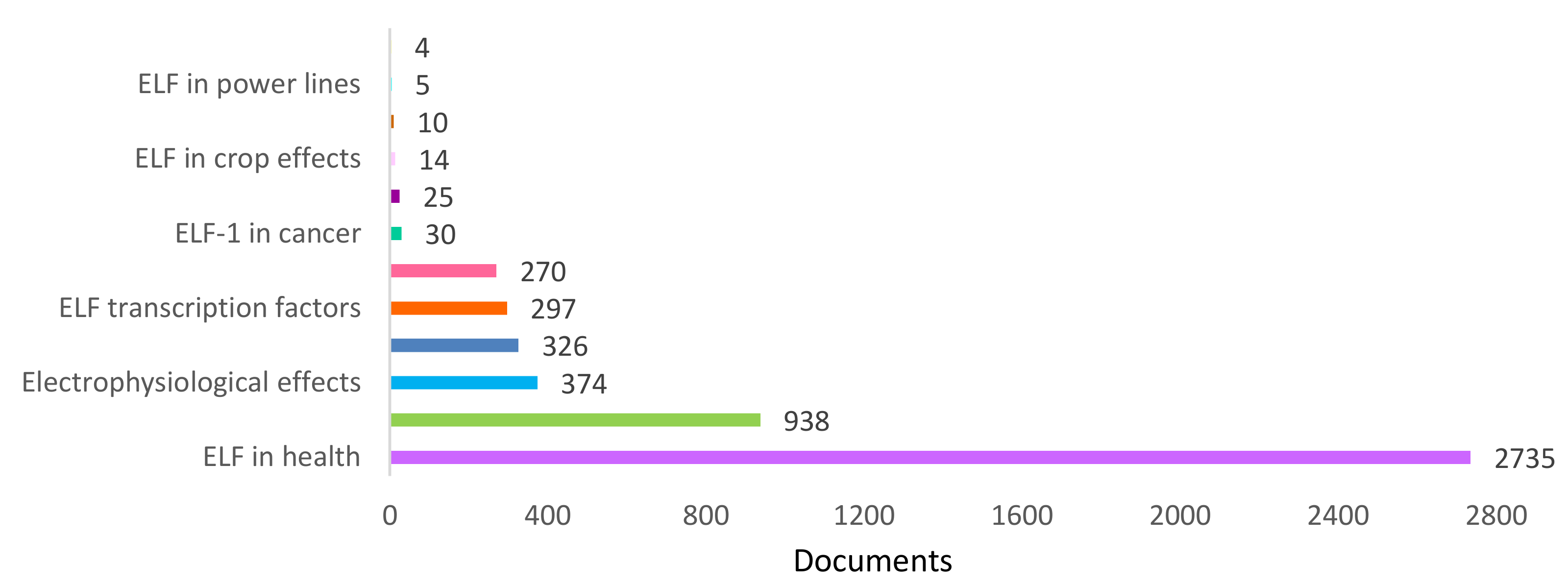



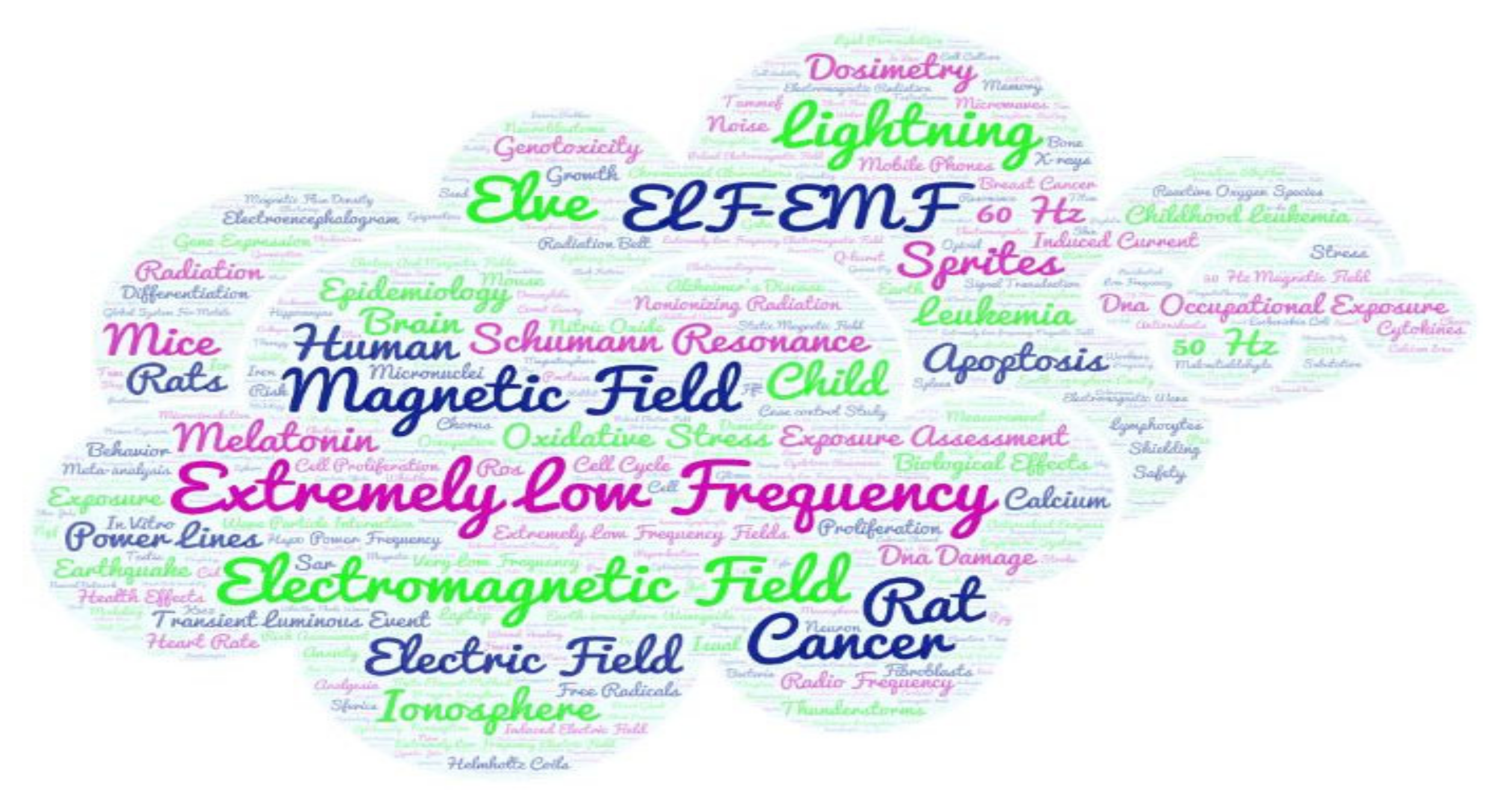
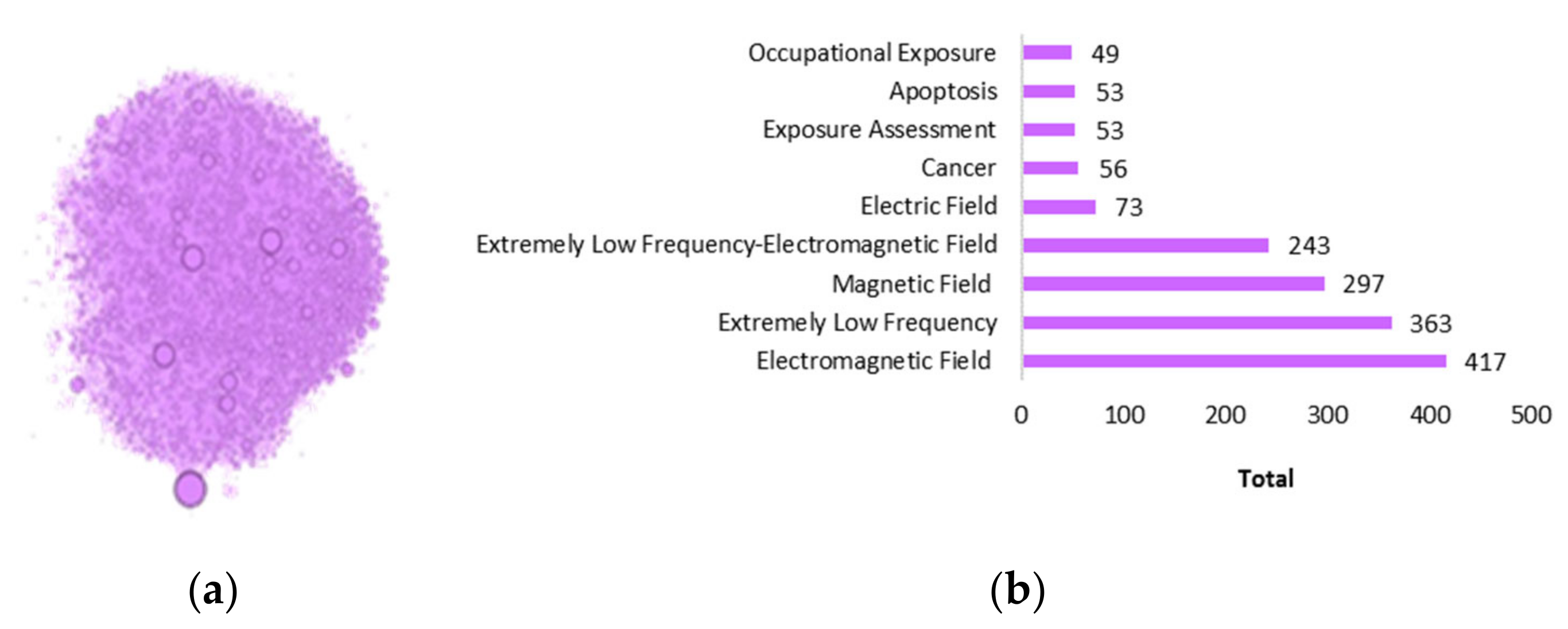
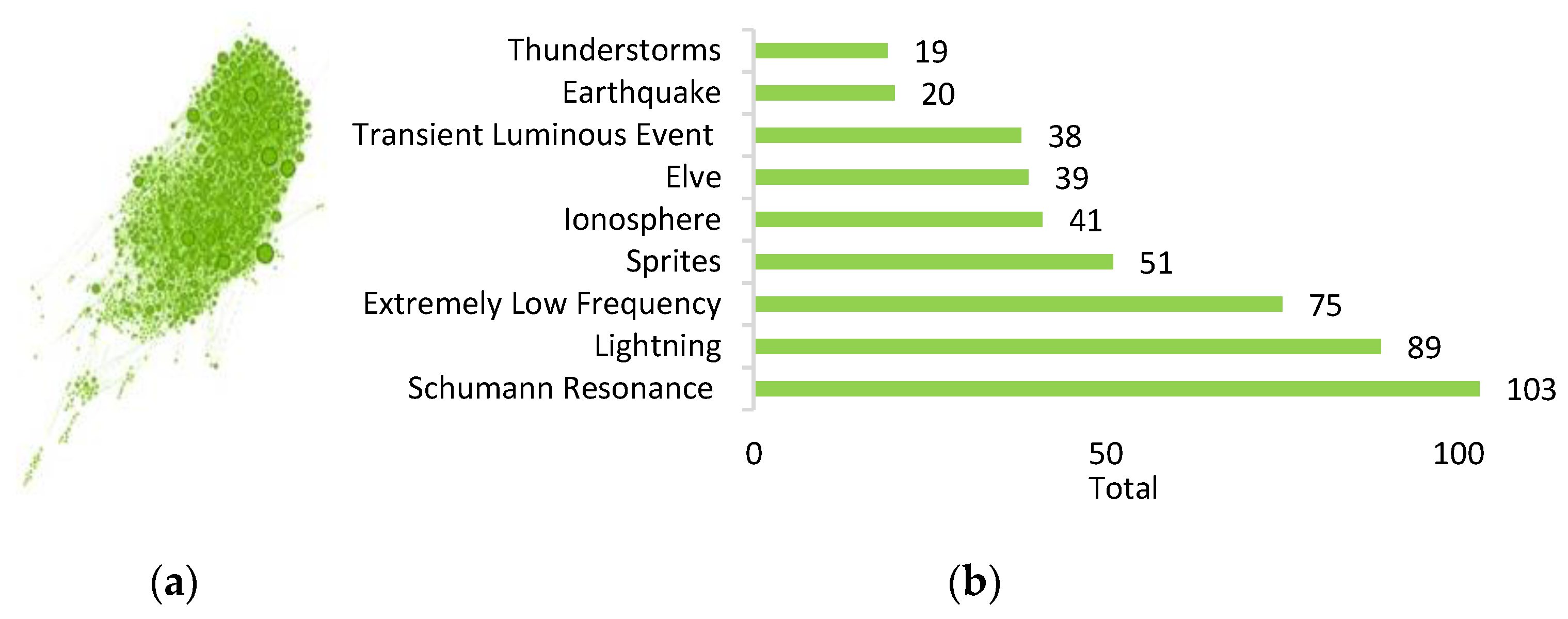
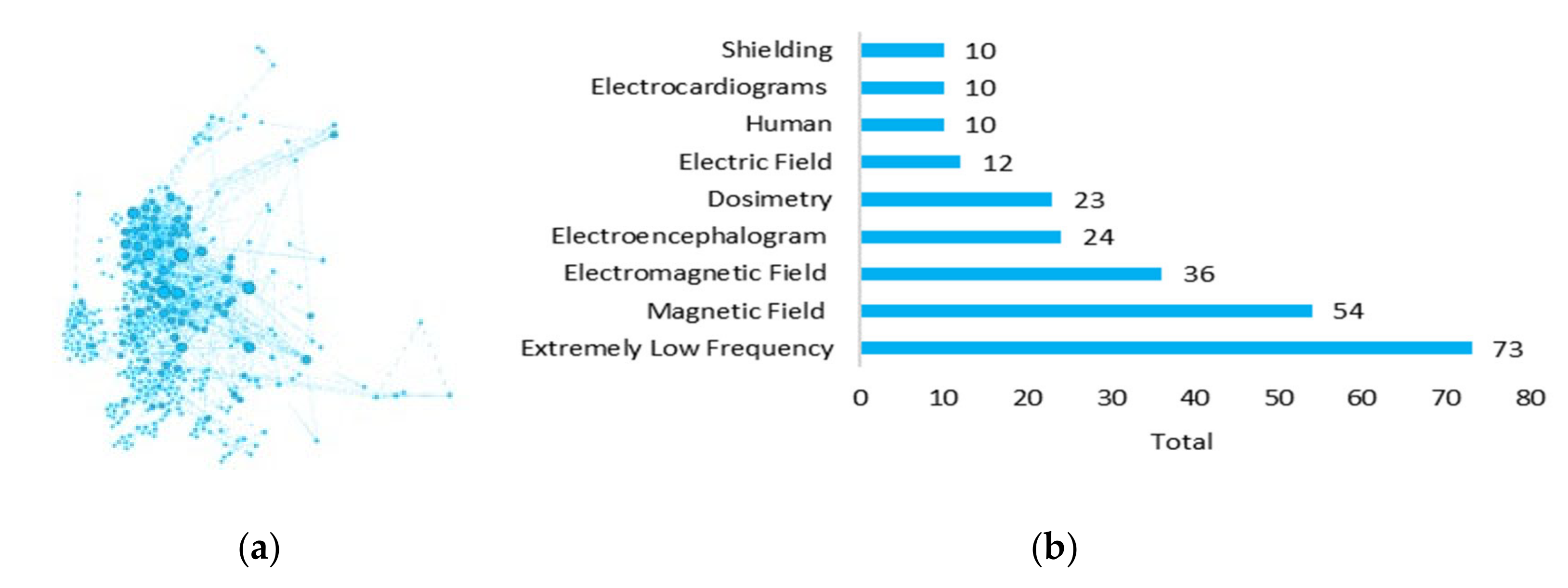

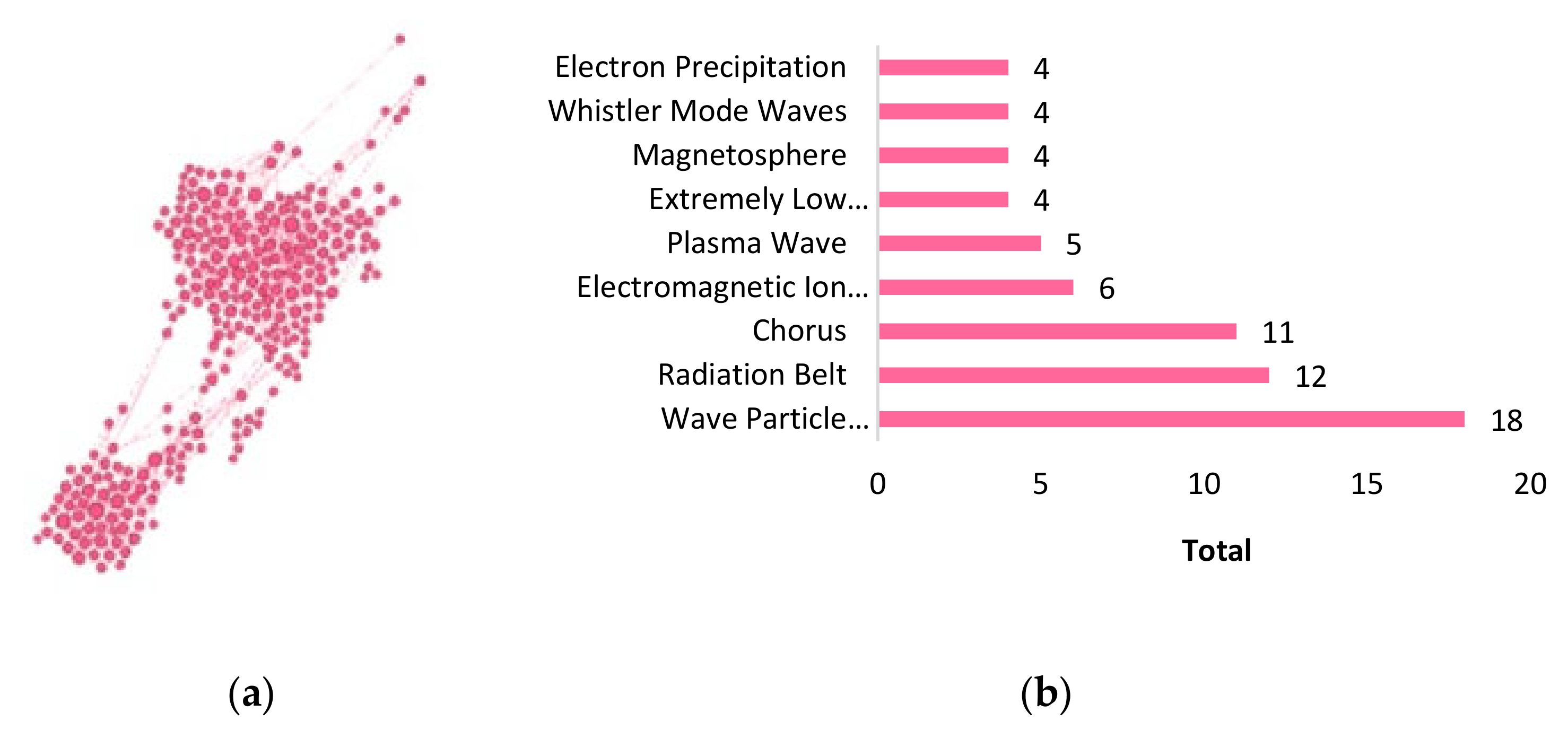
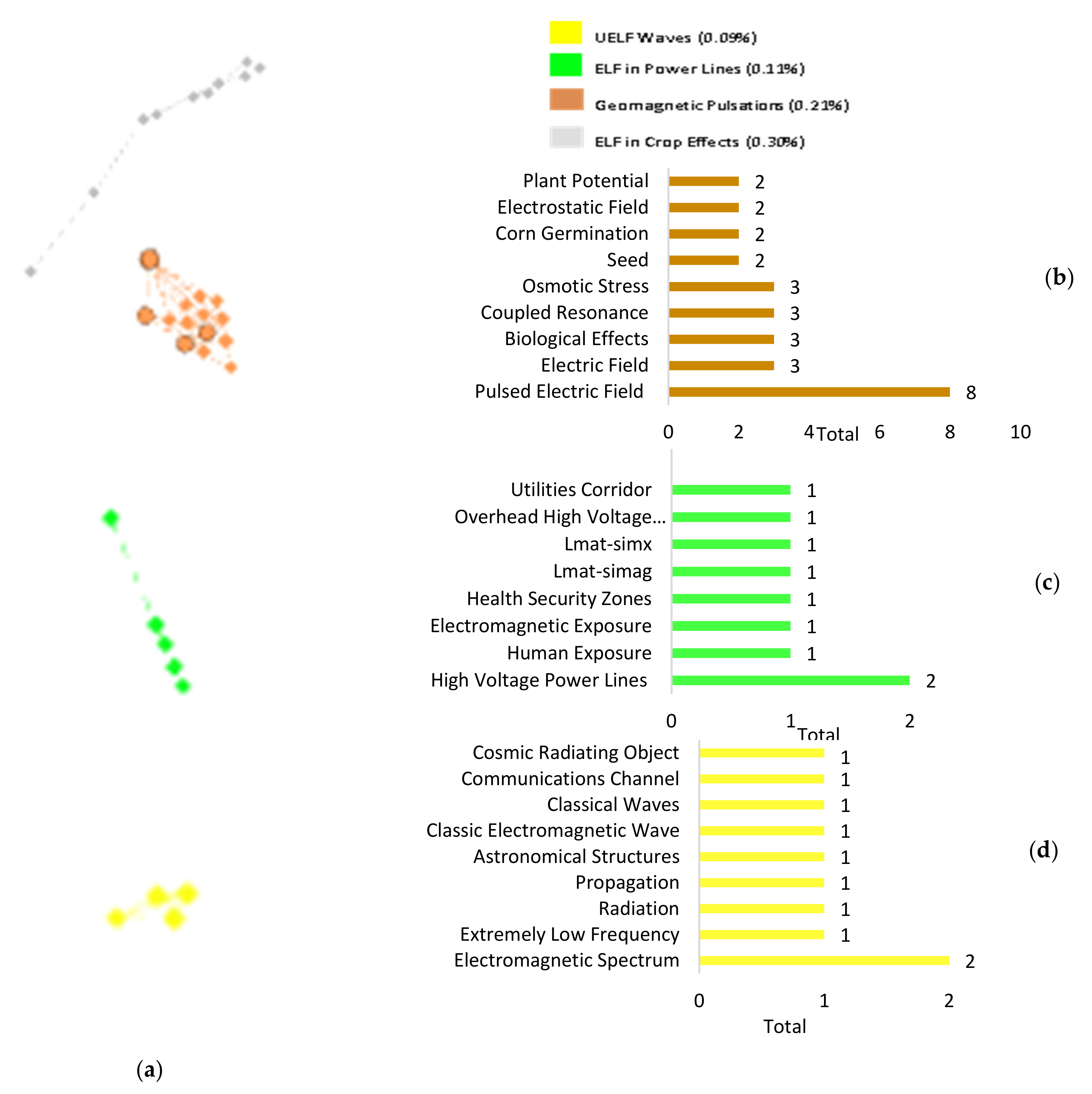
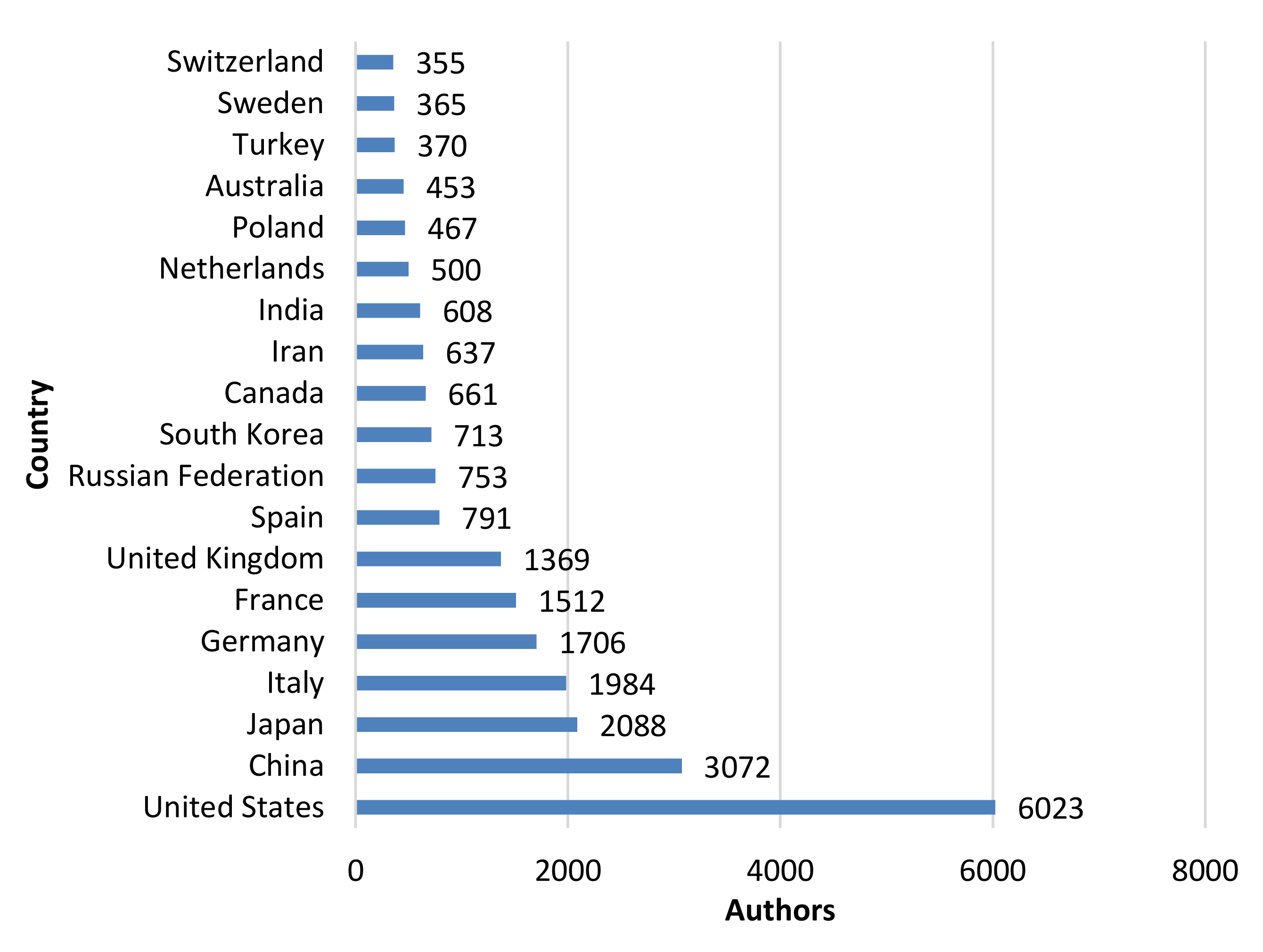

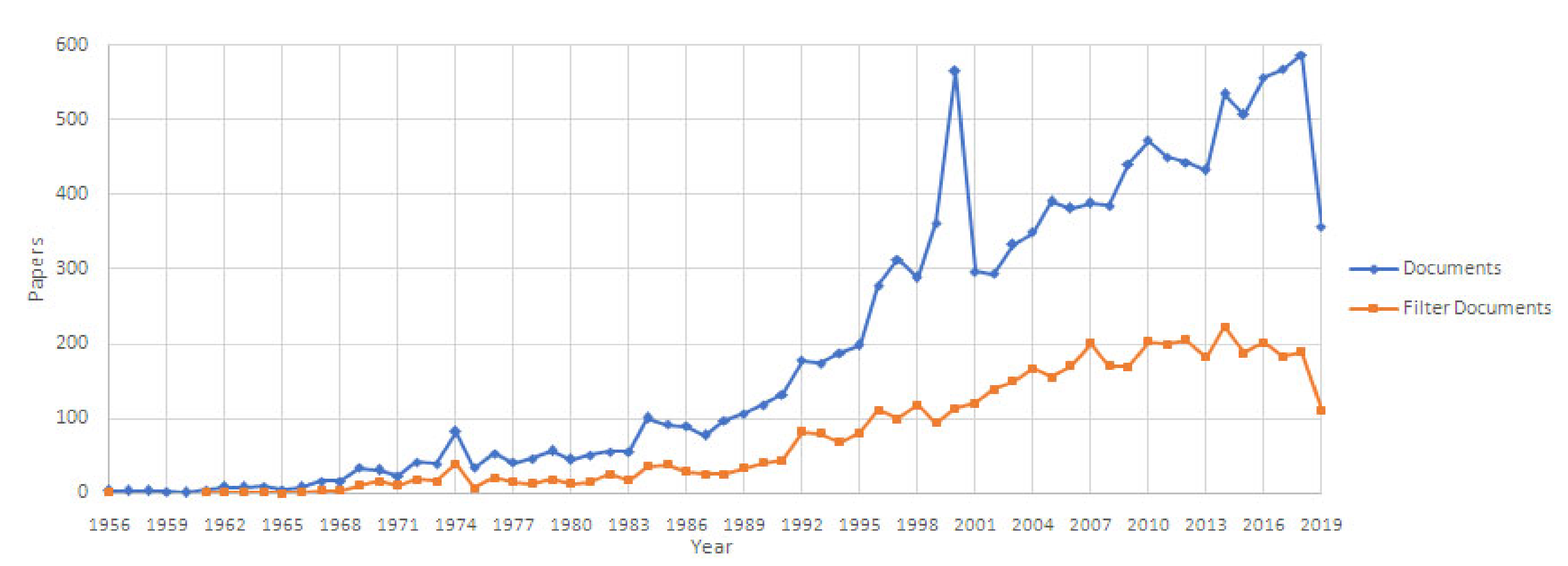
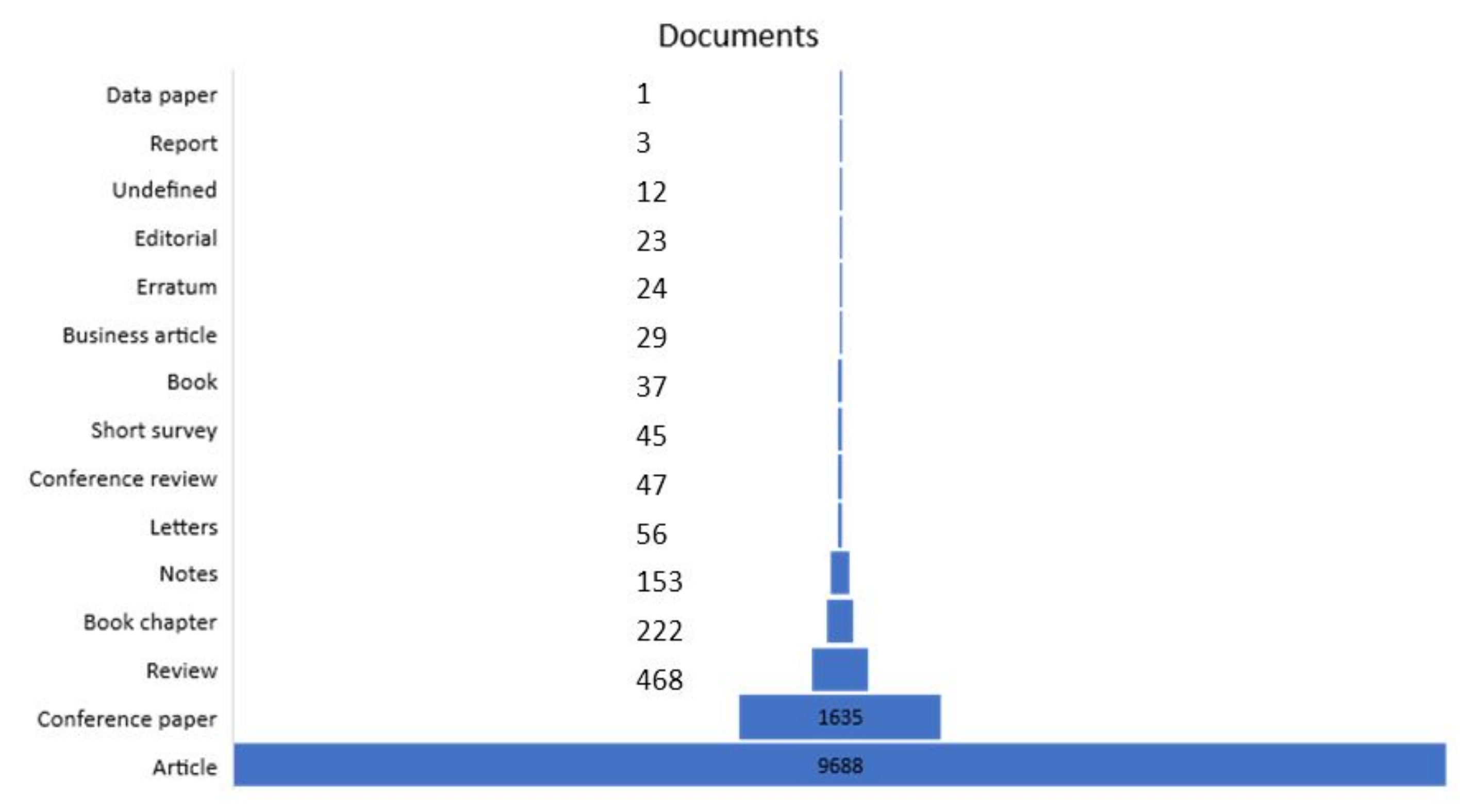
| Indexed Name | H-Index | Citation_Count | Document_Count | University (Country) | First Publication (Year) | Community |
|---|---|---|---|---|---|---|
| Reíter R. | 150 | 93,111 | 1530 | University of Texas Health Science Center at San Antonio (United States) | 2005 | ELF in health |
| Pascual- Leone Á. | 139 | 64,092 | 768 | Harvard Medical School (United States) | 2005 | ELF in health |
| Egger M. | 136 | 138,490 | 917 | Institut fur Sozial- und Praventivmedizin (Switzerland) | 2009 | ELF in health |
| Winblad B. | 130 | 70,964 | 1101 | Karolinska University Hospital (Sweden) | 2010 | ELF in health |
| Boffetta P. | 123 | 63,930 | 1212 | Icahn School of Medicine at Mount Sinai (United States) | 2005 | ELF in health |
| Elliott P. | 119 | 56,983 | 552 | Imperial College London (United Kingdom) | 2009 | ELF in health |
| Pedersen N. | 109 | 51,329 | 739 | Karolinska Institutet (Sweden) | 2005 | ELF in health |
| Giles G. | 105 | 50,474 | 1081 | Melbourne School of Population and Global Health (Australia) | 2017 | ELF in health |
| Greenland S. | 104 | 42,346 | 526 | University of California (United States) | 2005 | ELF in health |
| Tumino R. | 102 | 49,768 | 984 | Azienda Ospedaliera Civile M.P. Arezzo (Italy) | 2005 | ELF in health |
| Sun D. | 101 | 28,827 | 686 | University College Dublin (Ireland) | 2005 | ELF in health |
| Franceschi C. | 99 | 43,732 | 889 | Istitutodelle Scienze Neurologiche di Bologna (Italy) | 2014 | ELF in health |
| das Neves J. | 99 | 53,805 | 802 | i3S - Instituto de Investigação e Inovação em Saúde, Universidade do Porto (Portugal) | 2017 | ELF in health |
| Waterfield M. | 98 | 41,191 | 269 | UCL (United Kingdom) | 2005 | ELF in health |
| Pukkala E. | 97 | 40,078 | 731 | Finnish Cancer Registry (Finland) | 2005 | ELF in health |
| Arai Y. | 97 | 50,687 | 1071 | High Energy Accelerator Research Organization (Japan) | 2012 | Lightning ELF phenomena |
| Cline D. | 96 | 47,019 | 898 | University of California (United States) | 2007 | Lightning ELF phenomena |
| Rizzuto R. | 95 | 33,301 | 302 | Universitàde gli Studi di Padova (Italy) | 2005 | ELF in health |
| Miller A. | 95 | 35,519 | 471 | University of Toronto (Canada) | 2010 | ELF in health |
| van den Brandt P. | 94 | 35,660 | 472 | Maastricht University (Netherlands) | 2005 | ELF in health |
| Source Tittle | Year | ||
|---|---|---|---|
| 1999 | 2000 | 2001 | |
| Petroleum intelligence weekly | 6 | 53 | 2 |
| Middle East Economic survey | 0 | 40 | 0 |
| European chemical news | 2 | 30 | 0 |
| Petro strategies | 2 | 29 | 0 |
| Bioelectromagnetics | 9 | 20 | 23 |
© 2020 by the authors. Licensee MDPI, Basel, Switzerland. This article is an open access article distributed under the terms and conditions of the Creative Commons Attribution (CC BY) license (http://creativecommons.org/licenses/by/4.0/).
Share and Cite
García, R.M.; Novas, N.; Alcayde, A.; El Khaled, D.; Fernández-Ros, M.; Gazquez, J.A. Progress in the Knowledge, Application and Influence of Extremely Low Frequency Signals. Appl. Sci. 2020, 10, 3494. https://doi.org/10.3390/app10103494
García RM, Novas N, Alcayde A, El Khaled D, Fernández-Ros M, Gazquez JA. Progress in the Knowledge, Application and Influence of Extremely Low Frequency Signals. Applied Sciences. 2020; 10(10):3494. https://doi.org/10.3390/app10103494
Chicago/Turabian StyleGarcía, Rosa M., Nuria Novas, Alfredo Alcayde, Dalia El Khaled, Manuel Fernández-Ros, and José Antonio Gazquez. 2020. "Progress in the Knowledge, Application and Influence of Extremely Low Frequency Signals" Applied Sciences 10, no. 10: 3494. https://doi.org/10.3390/app10103494
APA StyleGarcía, R. M., Novas, N., Alcayde, A., El Khaled, D., Fernández-Ros, M., & Gazquez, J. A. (2020). Progress in the Knowledge, Application and Influence of Extremely Low Frequency Signals. Applied Sciences, 10(10), 3494. https://doi.org/10.3390/app10103494










